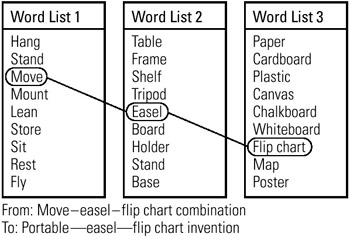Tool 179: Semantic Intuition
| AKA | N/A |
| Classification | Idea Generating (IG) |
Tool description
Semantic intuition is an idea-generating tool used by teams to create a product or process invention by combining words from two or three previously brainstormed lists all related to a problem area. Developed by the Battelle Institute (Frankfurt), the idea is to back into an invention by first naming it, then checking to see if it is feasible to implement. This is the reverse of the usual process of inventing first and then implementing.
Typical application
-
To discover an invention by word association.
-
To search for creative solutions to a problem.
-
To identify word combinations that may result in a new product, process, or service.
Problem-solving phase
| → | Select and define problem or opportunity |
| → | Identify and analyze causes or potential change |
| Develop and plan possible solutions or change | |
| Implement and evaluate solution or change | |
| Measure and report solution or change results | |
| Recognize and reward team efforts |
Typically used by
| Research/statistics | |
| 1 | Creativity/innovation |
| Engineering | |
| Project management | |
| Manufacturing | |
| 3 | Marketing/sales |
| Administration/documentation | |
| Servicing/support | |
| Customer/quality metrics | |
| 2 | Change management |
before
-
Brainstorming
-
Forced association
-
Forced Choice
-
Idea Borrowing
-
Round Robin Brainstorming
after
-
Analogy and Metaphor
-
Checkerboard Method
-
Creativity Assessment
-
Run-It-By
-
Presentation
Notes and key points
-
Two-and three-word combinations may increase the probability of finding inventions.
-
For use by individuals or teams of 6–8 participants.
Step-by-step procedure
-
STEP 1 The first step requires the team to define a problem area. See example Lack of Funds to Purchase Training Equipment for Each Classroom; Solution: Portable Flip Chart Easel.
-
STEP 2 The team brainstorms two or three wordlists that are linked or related to the problem. Wordlists are displayed side-by-side for the team to view during this process.
-
STEP 3 Next, words are combined or associated to form new names or potential ideas. The team systematically scans all wordlists in order to surface many combinations.
-
STEP 4 Discussions take place on word combinations that need further exploration. An attempt is made to visualize a new product, process, or service.
-
STEP 5 Potential inventions are listed by circling the words and connecting the words with lines (links) drawn from one wordlist to the other(s), as shown in the example.
Example of tool application
Lack of Funds to Purchase Training Equipment for Each Classroom
Solution: Portable Flip Chart Easel

EAN: 2147483647
Pages: 326